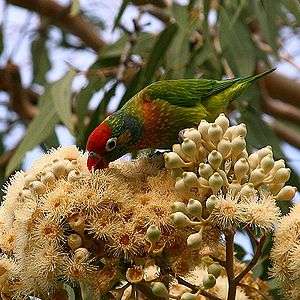Psitteuteles
| Psitteuteles | |
|---|---|
_-upper_body-6-2c.jpg) | |
| Iris lorikeet with a sunflower seed in its beak | |
| Scientific classification | |
| Kingdom: | Animalia |
| Phylum: | Chordata |
| Class: | Aves |
| Order: | Psittaciformes |
| Superfamily: | Psittacoidea |
| Family: | Psittaculidae |
| Subfamily: | Loriinae |
| Tribe: | Loriini |
| Genus: | Psitteuteles Bonaparte, 1854 |
Psitteuteles is a genus of parrot in the family Psittaculidae.
Taxonomy
The Psitteuteles genus contains three species:[1]
Psitteuteles, Bonaparte 1854
- Psitteuteles versicolor, (Lear 1831) (varied lorikeet)
- Psitteuteles iris, (Temminck 1835) (iris lorikeet)
- Psitteuteles iris iris, (Temminck 1835)
- Psitteuteles iris wetterensis, (Hellmayr 1912)
- Psitteuteles goldiei, (Sharpe 1882) (Goldie's lorikeet)
Species
| Species | |||
|---|---|---|---|
| Common and binomial names[1] | Image | Description | Range |
| Varied lorikeet (Psitteuteles versicolor) |
 |
19 cm (7.5 in) long. Mainly green with short yellow longitudinal streaks. The lores, forehead, and crown are red. The beak is red, the bare eye-rings are white, the lores are bare, and the irises are orange-yellow. The upper breast is mauve with longitudinal yellow streaks. The legs are bluish-grey. Females are duller and have less the red on the head.[2] | A monomorphic species native to northern Australia[3] |
| Iris lorikeet (Psitteuteles iris) |
 |
20 cm (8 in) long. Mostly green with pale-green transverse striations on its underside. The top of the head is red and there is a purple band from the eyes extending over the ears. The beak is red-orange, the iris is orange, and the legs are bluish-grey. The red on the head of the female is paler and less extensive. The extent and shade of the red and purple on the head varies between two or three subspecies.[2] | Timor and Wetar Island[2][4] |
| Goldie's lorikeet (Psitteuteles goldiei) |
 |
19 cm (7.5 in) long. It is mainly green, and its underside is yellow-green with dark green longitudinal streaks. It has red plumage over the crown, which is less extensive in the female. The back of its head is blue, its cheeks are mainly mauve and blue, its beak is black, and its irises are brown. Its legs are greenish-brown.[2] | A monomorphic species native to the highlands of New Guinea (usually 1000 to 2200 m ASL)[2] of Indonesia and Papua New Guinea[5] |
References
- 1 2 "Zoological Nomenclature Resource: Psittaciformes (Version 9.004)". www.zoonomen.net. 2008-07-05.
- 1 2 3 4 5 Forshaw (2006). plate 14.
- ↑ BirdLife International (2008). "Psitteuteles versicolor". IUCN Red List of Threatened Species. Version 2008. International Union for Conservation of Nature. Retrieved 2 October 2009.
- ↑ BirdLife International (2008). "Psitteuteles iris". IUCN Red List of Threatened Species. Version 2008. International Union for Conservation of Nature. Retrieved 2 October 2009.
- ↑ BirdLife International (2008). "Glossopsitta concinna". IUCN Red List of Threatened Species. Version 2008. International Union for Conservation of Nature. Retrieved 2 October 2009.
Cited texts
- Forshaw, Joseph M. (2006). Parrots of the World; an Identification Guide. Illustrated by Frank Knight. Princeton University Press. ISBN 0-691-09251-6.
External links
| Wikimedia Commons has media related to Psitteuteles. |
This article is issued from Wikipedia - version of the 9/3/2016. The text is available under the Creative Commons Attribution/Share Alike but additional terms may apply for the media files.